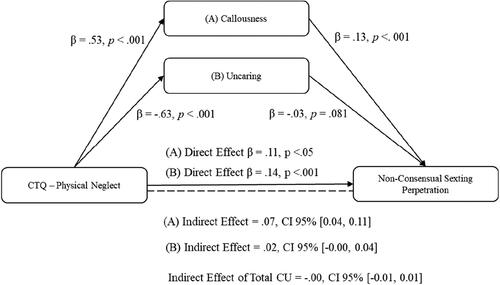Figures & data
Table 1. Pearson and spearman correlations (r) among variables.
Table 2. Group differences for childhood trauma and callous-unemotional traits in non-consensual sexting perpetration.
Figure 1. Statistical mediation of the association between emotional neglect and non-consensual sexting behavior mediated by uncaring and callousness traits.
Note. CTQ = Childhood Traumatic Questionnaire; CI = Confidence Interval. Solid lines indicate direct effect; Doted lines indicate indirect effect.
Regarding the relationship between physical abuse and non-consensual sexting, callousness trait (indirect effect = .06, 95% CI [0.03, 0.11]) and uncaring traits (Indirect effect = .01, CI 95% [0.00, 0.03]) partially mediated the mentioned relationship. However, CU traits (Indirect effect = .00, CI 95% [-0.00, 0.01]) did not mediate the relationship. The results of mediation analyses are reported in .
![Figure 1. Statistical mediation of the association between emotional neglect and non-consensual sexting behavior mediated by uncaring and callousness traits.Note. CTQ = Childhood Traumatic Questionnaire; CI = Confidence Interval. Solid lines indicate direct effect; Doted lines indicate indirect effect.Regarding the relationship between physical abuse and non-consensual sexting, callousness trait (indirect effect = .06, 95% CI [0.03, 0.11]) and uncaring traits (Indirect effect = .01, CI 95% [0.00, 0.03]) partially mediated the mentioned relationship. However, CU traits (Indirect effect = .00, CI 95% [-0.00, 0.01]) did not mediate the relationship. The results of mediation analyses are reported in Figure 2.](/cms/asset/07950721-cece-4044-b922-89e563f7378d/wjcc_a_2152146_f0001_b.jpg)
Figure 2. Statistical mediation of the association between physical abuse and non-consensual sexting behavior mediated by uncaring and callousness traits.
Note. CTQ = Childhood Traumatic Questionnaire; CI = Confidence Interval. Solid lines indicate direct effect; Doted lines indicate indirect effect.
The estimated indirect effects showed that callousness traits (Indirect effect = .07, 95% CI [0.04, 0.12]) and uncaring traits (Indirect effect = .01, CI 95% [0.00, 0.03]) are partial mediators of the relationship between sexual abuse and non-consensual sexting. Regarding CU traits, these acted as non-mediators of the relationship between sexual abuse and non-consensual sexting behavior (Indirect effect = .00, CI 95% [-0.00, 0.01]). The results of mediation analyses are reported in .
![Figure 2. Statistical mediation of the association between physical abuse and non-consensual sexting behavior mediated by uncaring and callousness traits.Note. CTQ = Childhood Traumatic Questionnaire; CI = Confidence Interval. Solid lines indicate direct effect; Doted lines indicate indirect effect.The estimated indirect effects showed that callousness traits (Indirect effect = .07, 95% CI [0.04, 0.12]) and uncaring traits (Indirect effect = .01, CI 95% [0.00, 0.03]) are partial mediators of the relationship between sexual abuse and non-consensual sexting. Regarding CU traits, these acted as non-mediators of the relationship between sexual abuse and non-consensual sexting behavior (Indirect effect = .00, CI 95% [-0.00, 0.01]). The results of mediation analyses are reported in Figure 3.](/cms/asset/9cd45e6d-9943-4d77-befc-122c629d84fc/wjcc_a_2152146_f0002_b.jpg)
Figure 3. Statistical mediation of the association between sexual abuse and non-consensual sexting behavior mediated by uncaring and callousness trait.
Note. CTQ = Childhood Traumatic Questionnaire; CI = Confidence Interval. Solid lines indicate direct effect; Doted lines indicate indirect effect.
Emotional abuse and non-consensual sexting were found to be partially mediated by callousness traits (Indirect effect = .04, CI 95% [0.02, 0.07]) while uncaring traits (Indirect effect = .00, CI 95% [-0.00, 0.02]) and CU traits (Indirect effect = .00, CI 95% [-0.00, 0.01]) acted as non-mediators of the relationship. The results of the mediation analyses are reported in .
![Figure 3. Statistical mediation of the association between sexual abuse and non-consensual sexting behavior mediated by uncaring and callousness trait.Note. CTQ = Childhood Traumatic Questionnaire; CI = Confidence Interval. Solid lines indicate direct effect; Doted lines indicate indirect effect.Emotional abuse and non-consensual sexting were found to be partially mediated by callousness traits (Indirect effect = .04, CI 95% [0.02, 0.07]) while uncaring traits (Indirect effect = .00, CI 95% [-0.00, 0.02]) and CU traits (Indirect effect = .00, CI 95% [-0.00, 0.01]) acted as non-mediators of the relationship. The results of the mediation analyses are reported in Figure 4.](/cms/asset/750758fd-20a6-4ad9-bef7-57caa102117b/wjcc_a_2152146_f0003_b.jpg)
Figure 4. Statistical mediation of the association between emotional abuse and non-consensual sexting behavior mediated by uncaring and callousness traits.
Note. CTQ = Childhood Traumatic Questionnaire; CI = Confidence Interval. Solid lines indicate direct effect; Doted lines indicate indirect effect.
Estimated indirect effects showed that callousness traits acted as a partial mediator between physical neglect and non-consensual sexting behavior (Indirect effect = .07, CI 95% [0.04, 0.11]), while uncaring traits (Indirect effect = .02, CI 95% [-0.00, 0.04]) and CU traits were found as non-mediators of the relationship (Indirect effect = −.00, CI 95% [-0.01, 0.01]). The results of the mediation analyses are reported in .
![Figure 4. Statistical mediation of the association between emotional abuse and non-consensual sexting behavior mediated by uncaring and callousness traits.Note. CTQ = Childhood Traumatic Questionnaire; CI = Confidence Interval. Solid lines indicate direct effect; Doted lines indicate indirect effect.Estimated indirect effects showed that callousness traits acted as a partial mediator between physical neglect and non-consensual sexting behavior (Indirect effect = .07, CI 95% [0.04, 0.11]), while uncaring traits (Indirect effect = .02, CI 95% [-0.00, 0.04]) and CU traits were found as non-mediators of the relationship (Indirect effect = −.00, CI 95% [-0.01, 0.01]). The results of the mediation analyses are reported in Figure 5.](/cms/asset/b73e9c38-5bae-4605-8aef-88fd24a173ba/wjcc_a_2152146_f0004_b.jpg)
Figure 5. Statistical mediation of the association between physical neglect and non-consensual sexting behavior mediated by uncaring and callousness traits.
Note. CTQ = Childhood Traumatic Questionnaire; CI = Confidence Interval. Solid lines indicate direct effect; Doted lines indicate indirect effect.

